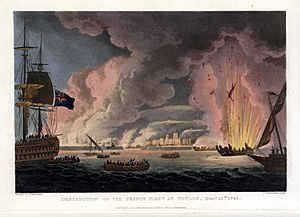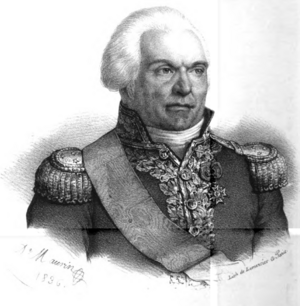Mediterranean campaign of 1793–1796 facts for kids
Quick facts for kids Mediterranean campaign |
|||||||
|---|---|---|---|---|---|---|---|
| Part of the War of the First Coalition | |||||||
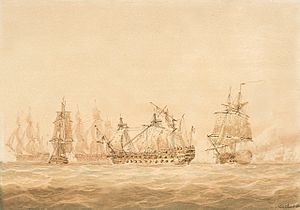 The 'Agamemnon' engaging the Ca Ira', 13 March 1795, Nicholas Pocock |
|||||||
|
|||||||
| Belligerents | |||||||
| Commanders and leaders | |||||||
The Mediterranean campaign of 1793–1796 was a big part of the early French Revolutionary Wars. This campaign happened during the War of the First Coalition. It was mainly fought in the western Mediterranean Sea. The main groups fighting were the French Navy and the British Royal Navy. The British also had help from the Spanish Navy and smaller navies from Italian states.
Most of the fighting took place in the Ligurian Sea. The British tried to stop French ships from leaving their ports. This was called a blockade. The French tried to break this blockade. There were also smaller fights along trade routes. These involved single warships or small groups of ships.
The campaign started in December 1792. The French tried to attack the neutral island of Sardinia but failed. In February 1793, France declared war on Great Britain. Britain sent a fleet to the Mediterranean. This fleet was led by Admiral Lord Hood. Its job was to protect British trade routes.
The French Navy was not well organized at this time. This was because of big changes happening in France. So, they could not fight the British and their allies at first. In August 1793, Lord Hood and his allies took control of Toulon. They also captured the entire French fleet there. This happened after people in Toulon who supported the king rebelled.
French armies then surrounded Toulon for four months. A young Napoleon Bonaparte was part of these armies. The allies were eventually forced to leave. The French fleet was taken back. However, the British had destroyed almost half of the French ships before leaving.
While the French repaired their ships, Lord Hood spent 1794 capturing the island of Corsica. He wanted to use Corsica as a base to blockade Toulon. This took longer than planned. By 1795, Lord Hood had retired. William Hotham took over his command.
Hotham faced the repaired French fleet. It was led by Pierre Martin. Martin led his ships out of Toulon several times. This led to two battles that did not have clear winners. These were the battles of Genoa and the Hyères Islands. Martin then sent smaller groups of ships to attack British trade.
By 1796, Britain's allies had left the war. This was due to French army successes in Italy and talks with Spain. Spain declared war on Britain in September. This left the British fleet caught between two strong enemies. The British leaders did not want to risk losing their fleet. So, they pulled their ships out of the Mediterranean. The British fleet, now led by Sir John Jervis, moved to the Tagus river. This meant they left the Mediterranean Sea.
Contents
Why the War Started
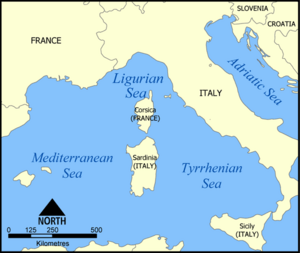
After the French Revolution in 1789, France became a republic. The new French Republic went to war with the Austrian Empire and Prussia in 1792. Other countries joined them after the French king Louis XVI was executed in January 1793.
Great Britain joined this group, called the War of the First Coalition, on February 1, 1793. They planned to start a new part of the war in the Mediterranean Sea.
In 1793, the Ottoman Empire controlled the eastern Mediterranean. They were officially neutral but important for trade. Their North African cities had many pirate ships. These pirates attacked ships from all countries.
In the Adriatic Sea, only the small navy of the Republic of Venice opposed the Ottomans. The Italian peninsula was split into many states. The Austrian Empire controlled the north. The Kingdom of Naples controlled the south. None of these Italian states had strong navies. But their ports were important for trade.
The main powers in the west were France and Spain. France had a large fleet at Toulon. Spain also had a big fleet. However, Spain had not invested much in its navy. This made it less organized. Spain was also a reluctant ally of Britain. They still felt angry about the Nootka Crisis.
The French fleet was in disarray at the start of the war. Many experienced officers left because they were from noble families. Sailors were also caught up in revolutionary feelings. The fleet at Toulon had a lot of internal fighting. In September 1792, the commander of the Mediterranean Fleet was killed by a mob.
Britain did not have many colonies or naval bases in the Mediterranean. Gibraltar was their only fortified port. It was captured in 1704. Britain had lost Minorca to Spain earlier. But Britain had strong trade interests in the Mediterranean. They often sent fleets there during wars to protect their trade.
The Royal Navy was ready for war. It had been updated since the American war. At the start of the war, Britain only had a small group of ships in the Mediterranean. This group was led by Rear-Admiral Samuel Goodall.
First Battles and Deployments
The first big operation was a French attack on Sardinia. This island was part of the neutral Kingdom of Sardinia. A French fleet and army attacked Cagliari in January 1793. But they were pushed back. Another attack on La Maddalena also failed. The French fleet returned to Toulon in chaos. Their commander was replaced.
With the French in confusion, Britain looked for allies. They tried to get Spain to agree to a British commander for all allied fleets. Spain refused. They worried Britain wanted to weaken both French and Spanish navies.
Britain still put together a fleet for the Mediterranean. This was despite not having enough sailors. Vice-Admiral Lord Hood was given command. Ships were sent out as they were ready. Lord Hood followed with his main group of ships in May. His flagship was HMS Victory.
As Hood's fleet sailed towards the Ligurian Sea, a Spanish group of ships patrolled off Southern France. But they had to leave in June because many sailors were sick. During this time, the French ships stayed in Toulon. Many were ready, but some were being repaired.
In June, the city council in Toulon expelled radical groups. They sided with more moderate groups. The French fleet commander did not pick a side. But his deputy supported the revolution. Many sailors in the fleet agreed with him.
The Siege of Toulon
Lord Hood's fleet arrived near Toulon in mid-August. Soon, people from Toulon who supported the king offered to join forces. Hood agreed, but only if they would surrender Toulon and the French fleet. After talks, Hood's fleet, helped by a Spanish force, entered the city on August 27. They captured the entire French fleet.
In September, French Republican armies moved towards Toulon. Thousands of rebellious sailors were still in the port. Hood sent four French ships with these sailors to another port. But the allied army defending Toulon was not united. It had British, Spanish, Neapolitan, and French Royalist troops.
By late September, the French had captured some high ground near the town. A young artillery officer named Napoleon Bonaparte helped lead these attacks. Hood sent HMS Agamemnon, led by Captain Horatio Nelson, to Palermo. Nelson convinced the King of Naples to send troops for the siege. In October, these Neapolitan troops attacked, but the relationship between Hood and the Spanish admiral had become very bad.
Hood sent a group of ships to Genoa on October 5. They seized a French ship there. Because of this, the people of Genoa, who supported the French, stopped Austrian troops from going to Toulon. This weakened the allied position. Another French ship was taken from La Spezia soon after.
A French Royalist ship was lost in November. Hood also sent ships to Corsica. They tried to get French troops there to surrender. When this failed, they attacked San Fiorenzo but were pushed back. Nelson's ship joined them later. They sailed to Tunis, where French merchant ships were anchored. They tried to get permission to attack the French ships, but were refused.
At Toulon, a big Republican attack was stopped on November 15. But an allied attack two weeks later failed. On December 14, General Dugommier launched a major assault. It broke through the Neapolitan lines. Three days later, Spanish forts were lost. French cannons could now fire on the allied fleet.
Hood ordered his ships to move away and evacuate Toulon. As allied troops left the docks, British and Spanish teams entered the Arsenal. They were ordered to burn the French fleet. These teams destroyed eight large ships and two smaller ones. The allies took three large ships, six smaller ones, and eight corvettes. Most went to the British. The remaining 15 large ships were damaged but later repaired by the French.
Some historians accused the Spanish of trying to save the French fleet. They thought Spain did this to stop Britain from becoming too strong. Allied soldiers and over 7,000 Royalist refugees were safely removed. After the siege, many people in Toulon were killed by the Republicans. There was even a plan to destroy the town completely.
Capturing Corsica
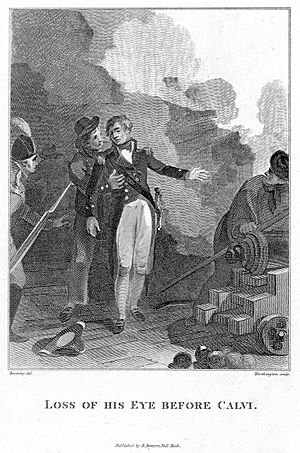
At the start of 1794, Hood's fleet was near the Îles d'Hyères. Hood ordered troops to land on Corsica. He wanted to capture the island from the French. He planned to use the Bay of San Fiorenzo as a safe place for his fleet. Corsica had been rebelling against France since July 1793.
Landings were made at San Fiorenzo in early February. The British forces, working with Corsican fighters, captured the town's main defenses by February 18. This forced the French to leave their ships and retreat to Bastia.
Bastia was a larger town with many soldiers. An argument between Hood and the army commander delayed the attack. Eventually, the army commander resigned. Nelson and Colonel William Villettes led the attack. They landed near Bastia on April 4. An attack from the sea was stopped by hot cannonballs. The town's strong guns led to a long siege through May. Bastia surrendered on May 22 when it ran out of food.
After these British victories, the Corsican people held elections on June 1. By June 16, they had a new constitution. This made the Anglo-Corsican Kingdom a self-governing part of the British Empire.
The final operation was at Calvi. Two large forts blocked the way to the town. Many British soldiers arrived from Gibraltar. They were led by Charles Stuart. He and Nelson landed troops near Calvi on June 17.
British guns were set up in good positions. The French forts were then attacked. Fort Mollinochesco was left by July 6. Fort Mozello was captured on July 18. Many British soldiers were hurt. Nelson lost an eye during the fighting. Over a thousand British soldiers got sick. The town was heavily damaged and surrendered on August 10.
The British sent their prisoners to Toulon. The French held the ships at first but later released them.
Hood and his fleet were not at the siege of Calvi. This was because the French fleet had finally left Toulon. It was led by Pierre Martin. On June 11, the fleets saw each other. The French retreated into a bay. Hood planned an attack, but it was too risky. Hood left, leaving a large group of ships to blockade the bay. But a storm drove them off, and Martin returned to Toulon in November.
Elsewhere, a British ship disappeared in April. It was thought to have exploded. In the Eastern Mediterranean, a British ship found a French ship in Mykonos harbor. The British captain attacked the French ship and forced it to surrender. In the autumn, the 70-year-old Hood was called back to Britain. Hotham took command of the fleet.
In December, there was a small mutiny on a British ship. Hotham solved it peacefully. In the last weeks of the year, Martin sent a group of French ships to raid British trade. They captured 25 merchant ships and 600 prisoners.
Battles in the Ligurian Sea
Hotham spent the winter patrolling from San Fiorenzo. A British ship, HMS Berwick, was damaged in a storm. While it was being repaired, Hotham sailed his fleet to Leghorn. He left Berwick behind with only temporary masts.
When Berwick followed, it ran right into Martin's fleet. Martin's fleet was on its way to the Gulf of Genoa. The damaged British ship tried to escape but was caught by French ships. In the battle that followed, the British captain was killed. Berwick was captured.
The next day, Hotham learned Martin was at sea. He sailed to find him. On March 13, he found the French near Cape Noli. As Martin fled back to Toulon, Hotham's ships attacked the French ships at the back. This was called the Battle of Genoa. Two French ships were defeated. But three days later, a damaged British ship was wrecked in a storm. Martin went back to the Îles d'Hyères. Hotham went to San Fiorenzo to repair his fleet.
Both fleets got more ships in the spring. A French force arrived at Toulon. They found the fleet there in a state of mutiny. This was resolved. Hotham was joined by more British ships. British and French scouting ships fought in June. That month, Martin sailed again. Hotham chased the French to the Îles d'Hyères. In the Battle of the Hyères Islands, the last French ship was cut off and destroyed. Hotham stopped the fight even though the French were running away. Martin was able to retreat to Toulon.
Attacks on Trade Routes
Martin did not take the main French fleet to sea again. Instead, he sent groups of ships to attack British trade. First, he sent a group into the Atlantic. They attacked a valuable British convoy from the Levant. A convoy is a group of ships traveling together for protection. The French ships then hid in the Spanish port of Cádiz.
Spain had signed a peace treaty with France on August 19. This was because France had won many battles. A British force was sent to blockade Cádiz. This meant they tried to stop ships from entering or leaving the port. Another French group attacked British trade in the Aegean Sea. They returned to Toulon before a British group could catch them.
Hotham stayed with his main fleet. He sent ships to bother French coastal convoys. These convoys were supporting the French army in Italy. A British group destroyed a large French supply convoy on August 26. Another British ship fought a French convoy on September 29.
On November 1, 1795, Sir John Jervis replaced Hotham. Jervis had 18 large ships. Towards the end of the year, François-Paul Brueys replaced Martin. Brueys had 15 large ships. Jervis was also worried about seven Spanish ships in Cartagena. Spain was still neutral, but they were getting closer to France.
In early 1796, Jervis sent several groups of ships to sea. One group seized three small French ships in a Tunisian harbor. Another group, led by Nelson, went to the Italian coast. Napoleon Bonaparte was winning many battles against Austrian and Sardinian armies there. On April 10, Nelson's force was ready to help with cannons. But the Austrians failed to hurt the French.
On April 25, a supply convoy was destroyed. On April 31, Napoleon's siege equipment was captured. This equipment was on a coastal convoy. Losing it later affected French efforts at the Siege of Mantua. Jervis stayed near Toulon. In April, a French ship accidentally burned. In June, Jervis sent a British ship to attack a French ship.
Nelson's actions could not stop Bonaparte's army. On May 15, the King of Sardinia signed a treaty. He gave large areas of land to France. Naples also sought peace soon after. Napoleon's army advanced and defeated the Austrians. This allowed French forces to spread across Northern Italy. They threatened Leghorn.
On June 27, Jervis ordered a quick evacuation of people and supplies from the harbor. A British ship came under heavy fire from French troops as it left. Jervis responded by taking the Tuscan island of Elba. He wanted to stop the French from using it to attack Corsica.
In Corsica, people were becoming angry at the British. This was partly because the British tried to protect Corsicans who supported France. There was also fighting between different Corsican leaders. British efforts to collect taxes led to an armed uprising in early 1796. British troops moved against the rebels at first. But then the British leader managed to make a truce.
Leaving the Mediterranean
On September 12, 1796, France and Spain signed a treaty in Paris. Britain immediately stopped Spanish merchant ships from using British ports. They expected Spain to declare war. This happened on October 5.
Orders were sent to Jervis to leave Corsica. He was told to go to Gibraltar. This was because all British allies in the region were gone. Jervis had already called back a group of ships from Cádiz. But they sailed without getting new supplies. Jervis had to send them back to Gibraltar. In the week before the war declaration, the main Spanish fleet left Cádiz. They met the British ships returning. The British admiral left two transport ships and quickly retreated to Gibraltar.
The Spanish fleet sailed past Gibraltar into the Mediterranean. They joined with ships at Cartagena. This made a fleet of 26 large ships. This fleet sailed in the Ligurian Sea. They saw British scout ships. Jervis only had 14 large ships. He could have been overwhelmed. But the Spanish admiral chose not to attack. He went to Toulon and joined with the French fleet.
Jervis was now greatly outnumbered by 38 ships. He waited for his ships to return. But the junior admiral had decided to return to Britain on his own. By mid-October, it was clear he would not return. Jervis ordered a complete British withdrawal from the Mediterranean.
British ships had already fought Spanish scouts. On October 13, a British ship captured a Spanish ship near Cartagena. French forces landed in Corsica without a fight on October 19. Corsican rebels welcomed them. Jervis sent Nelson to evacuate British people and supporters from Bastia. Nelson threatened to destroy the town if anyone stopped him. He removed almost all British troops and supplies by October 21. French troops then appeared.
The French then moved through Corsican defenses to San Fiorenzo. The British had already left there. Then they moved to Ajaccio. By November 4, the whole island was back in French hands. The same day, Jervis prepared his fleet. He had many transport and merchant ships with him. He sailed west. He arrived at Gibraltar on December 11.
The Spanish fleet set out to chase him. A French group of ships joined them. But they were delayed. The French group continued alone. They passed Jervis and headed west into the Atlantic during a storm. The same storm wrecked a British ship on the Moroccan coast. Many lives were lost. On December 16, Jervis took his fleet out of the Straits of Gibraltar. He went to the mouth of the Tagus river near Lisbon. There, he could get supplies and more ships from Britain. During this trip, another British ship was wrecked.
With Jervis at Gibraltar, the only British force left in the Mediterranean was a small group under Nelson. They were sent to get the soldiers from Elba. On December 19, Nelson's ship was attacked by a Spanish ship. The Spanish ship was defeated. But Nelson had to leave it behind as more Spanish ships arrived. Nelson reached Portoferraio soon after. He took the remaining British troops and supplies from the island. He sailed back to Gibraltar on January 29, 1797. The last operation was by two British ships. They checked Toulon, Barcelona, and Cartagena. They arrived back at Gibraltar on February 10. They were the last British forces in the Mediterranean.
What Happened Next
Jervis had to go to the Tagus river. From there, he rebuilt his fleet with new ships from Britain. He focused on blockading Cádiz. He patrolled looking for the Spanish fleet. On February 14, 1797, he found a much larger Spanish force in fog. This was near Cape St. Vincent. He defeated the Spanish badly at the Battle of Cape St. Vincent. The Spanish retreated to Cádiz. They did not come out again for two years.
With Britain controlling the entrance to the Mediterranean, Jervis waited for a chance to return. His ships blockading Spain bothered the Spanish. This included a failed attack on Cádiz in June. And a bad battle in July where Nelson lost an arm.
It was not until the spring of 1798 that a British fleet could enter the Mediterranean again. This happened when a French army tried to invade Egypt. In the Mediterranean campaign of 1798, Nelson found the French fleet. He destroyed it at the Battle of the Nile. This made Britain the strongest naval power in the region again. It also started the War of the Second Coalition.
Historians have blamed Hotham for not defeating the French Navy in 1795. They also blamed Mann for leaving Jervis. One British ambassador wrote that Hotham was "not quite awake enough" for such an important command. Historians have criticized the British admiral for not being energetic enough. French victory in the campaign was due to their army's success, especially Napoleon's battles in Italy. Also, their talks with Spain left Britain alone and outnumbered.


